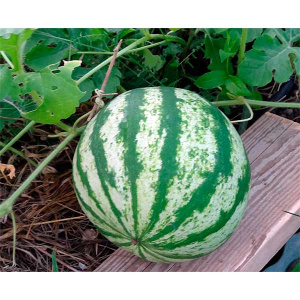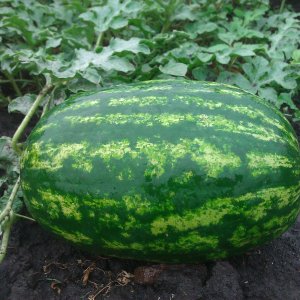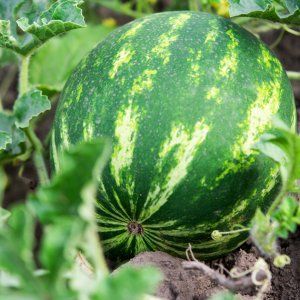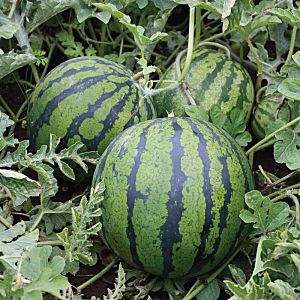How to plant and grow a watermelon correctly
Watermelon is one of the tastiest and healthiest summer treats. According to the Guinness Book of Records, the heaviest watermelon was grown in 2013 by an American farmer. The giant berry weighed 159 kg!
Melons, which include watermelon, are grown both in the south of Russia and in Siberia. We will tell you in detail how to plant a watermelon correctly, how to care for it and when it is time to harvest.
The content of the article
Variety selection
The cultivation of any crop begins with the selection of a variety. A hybrid or variety is chosen based on the characteristics of the climate of the region and the place of cultivation: in a greenhouse, open field or at home.
For cultivation in central Russia

The middle zone is the European part of Russia from the borders with Belarus in the west to the Volga region in the east and from Karelia and the Arkhangelsk region in the north to the Chernozem region. For these areas, early maturing varieties and hybrids that are resistant to temperature changes are chosen.
Popular early varieties and hybrids include Twinkle, Moscow Region Charleston F1, Ultra early, Crimson Sweet, Sugar baby, Skorik, Kai F1.
In the open field
For open ground, the most hardy hybrids and varieties of special selection are chosen. These are early ripening watermelons, resistant to cold weather.
Their fruits are not large, but they give a stable harvest in open field conditions. These are hybrids Orange Medoc F1, Champagne Pink F1, Prince Arthur F1.
At home

For growing at home, small-fruited and early-maturing crop varieties are chosen. They are also used for cultivation in greenhouses. Watermelons in these varieties are medium-sized, with a thin skin.
For growing at home, you can choose one of such varieties as: Gift to the Sun, Ogonyok, Sibiryak, Rose of the South-East.
Landing dates
They begin to plant watermelons in open ground when the soil warms up to a depth of about 10 cm. The optimum temperature for seedlings is + 15 ... + 16 ° С.
When grown through seedlings, seeds are sown in late April - early May. A separate container is used for each plant, since the watermelon does not tolerate transplanting well. Seedlings are planted in a permanent place about 30 days after sowing, when the threat of frost has passed.
Soil preparation
Melons and gourds do not like acidic soil, so fertile soil with a pH of 5.5-6 units is chosen for them. Preferred soil with a sandy or sandy structure.
The watermelon bed is prepared in the fall. The soil is dug up, compost, humus, organic and phosphorus-potassium fertilizers are applied. It is also helpful to add wood ash or dolomite flour.
Important! Watermelons, like all melons, grow well on compost heaps.
Unwanted precursors are legumes and cabbage. Favorable - onions, tomatoes, potatoes, winter wheat, rye. These crops increase the fertility of the soil and contribute to the ripening of watermelons 10-15 days ahead of schedule.
Seed preparation
In the southern regions of the country, seeds are planted directly into open ground. In the Urals and Siberia, it is preferable to use the seedling method. This will speed up the process of fruit growth and ripening. Seeds for seedlings are sown 4-5 weeks before planting in the garden.
Interesting fact. About 1200 different varieties of watermelon are known.All of them are divided into four categories: with seeds, without seeds, small watermelons and yellow watermelons.
Seed preparation improves germination. Seeds are wrapped in paper or cotton cloth and placed in warm water until sprouting. To protect seedlings from diseases, the seeds are kept in a solution of potassium permanganate and zinc for 24 hours.
After germination, the seeds are planted in separate peat or plastic cups with a diameter of 10-15 cm. The seedlings are ready for planting on the garden bed when 3-4 leaves appear. A week before transplanting, the plants begin to harden, gradually reducing the temperature.
Growing seedlings
In areas with short and cool summers, it is preferable to use seedlings. Seeds are planted from mid-April. Homemade watermelon seedlings grow in about 30 days.
The land for growing seedlings is used light and fertile. For the soil mixture, take one part of peat, one part of humus and 0.5 part of river sand. Ash is added to the mixture (2 tablespoons per liter).
Watermelon seedlings have delicate and brittle roots, they do not recover well after transplanting, so it is preferable to grow watermelons without picking. The seeds are planted in separate cups or pots with a capacity of about 0.3 liters and a diameter of 10-15 cm.
How to plant watermelons correctly? It is preferable to sow watermelon with pre-prepared seeds: disinfected and germinated.
The seeds are disinfected by keeping them in a dark pink solution of potassium permanganate for 30 minutes. Then the seeds are washed in clean water and wrapped in a damp cloth. Until the sprouts appear, the seeds are kept in a warm place at a temperature of + 25 ... + 30 ° C. The sprouts appear in about five days.
The hatched seeds are hardened. To do this, they are placed in a refrigerator for 12 hours. The procedure is repeated 2-3 times. Sowing is started when the root grows 1-1.5 cm.
Lighting and temperature
Watermelon is a light-loving southern plant, so the most illuminated place in the house is chosen for seedlings. As a rule, this is a southern or southeastern window sill.
Before emergence, the pots are placed in a warm place with an air temperature of + 25 ... + 27 ° C. After the sprouts appear, the temperature is reduced to + 20 ... + 22 ° С during the day and + 18 ... + 20 ° С at night. So the plants will get stronger and not stretch out.
Watering
Seedlings are watered sparingly, as the earthen coma dries. Waterlogging of the soil causes the development diseases and the death of sprouts.
Water is used at room temperature. When watering, avoid getting moisture on the stems and leaves of plants.
Top dressing
7-10 days after emergence, seedlings are fed with a solution of mineral fertilizers for seedlings (Fertika, Solution, Sotka). Top dressing is repeated after 10 days.
Bedding
Seedlings are transplanted with the appearance of 3-5 true leaves. The optimum soil temperature for planting is + 15 ... + 18 ° С.
Attention! Healthy watermelon seedlings are robust plants with thick stems and compact internodes.
They begin to plant in the second decade of June, when the threat of frost has completely passed. If you use shelters, you can plant the plants earlier, starting three weeks after sprouting.
The planting scheme is chosen based on the climbing capacity of the variety and the recommendations of the seed manufacturer. On average, two plants are planted per 1 sq. m.
First, the holes are prepared. About 2 kg of compost is added to each hole and watered abundantly. Seedlings are planted in holes on the ridges according to the scheme 140 × 70 or 140 × 140, deepening by 8-10 cm in the resulting gruel. In this case, the root collar remains 1-2 cm above the surface of the ridge. The holes are sprinkled with dry soil to avoid crust formation.
If the weather is still unstable, the plantings are covered with any covering material.
Sowing seeds in open ground
They begin to plant watermelons with seeds in open ground when warm weather sets in and the soil warms up to + 14 ° C and above. The seeds are buried 6-8 cm and watered with warm water. The first shoots appear a week after sowing.After the growth of 4-5 leaves, the soil is carefully loosened and the plants are spud.
Features of care for sprouts and ripening watermelons
After transplanting, young shoots are protected with a film from temperature changes and wind. The shelter is regularly raised for ventilation to prevent condensation from forming. The protection is removed in June, with the arrival of real heat.
Watering
Watermelon beds about once a week, avoiding moisture on the leaves and stems. To prevent the top soil from drying out too quickly, use a 4-5 cm layer of mulch. This technique also increases the temperature of the soil. During the flowering period, watering is reduced to once every two weeks, and during the period of fruit filling, it is completely stopped.
Top dressing
Two to three weeks after planting in a permanent place, the plants are fed. A solution of ammonium nitrate is introduced into the soil at the rate of 20 g per 1 bush. During the period of bud formation, feeding is repeated.
Formation of bushes
The formation of watermelon bushes consists in pinching the side shoots. This is true when growing crops in the middle lane, where there are not so many warm summer days. In such conditions, all formed fruits do not have time to ripen before the onset of cold weather.
4-6 ovaries are left on the main shoot. The remaining lashes are removed, leaving 3-4 sheets on them. They will help the plant get good nutrition.
In the process of growth, new stepchildren grow on the bush. They are also removed by periodically examining the plant.
Protection against diseases and pests
Damage to watermelon beds is caused by diseases such as anthracnose, fusarium, powdery mildew. The development of disease is prevented by the right growing conditions and the selection of disease resistant varieties.
The most common disease is anthracnose. Its development is provoked by excessive soil and air moisture. For prevention, every 10-12 days after the rain, watermelons are sprayed with Bordeaux liquid and copper oxychloride. Spraying is stopped three weeks before harvest.
Of the pests, aphids, wireworms, meadow moths, and scoops are dangerous. If insects are found, they are treated with biological products or chemical insecticides: "Tanrek", "Aktara", "Decis", "Fufanon".
From folk remedies, spraying with infusion of ash or garlic is used. The plants most infested with pests are removed from the garden and burned.
Harvesting and storage features
 The fruits begin to ripen approximately 40 days after pollination. If the watermelons are not ripe before the onset of cold weather, they are removed from the garden and stored in a cool room where ripening continues.
The fruits begin to ripen approximately 40 days after pollination. If the watermelons are not ripe before the onset of cold weather, they are removed from the garden and stored in a cool room where ripening continues.
The ripeness of watermelons is determined by the ringing sound when tapped and the dry tail. When squeezing a ripe fruit, a slight crackling of the pulp is heard. Also, a yellow spot on the side indicates ripeness.
Depending on the variety, watermelons can be stored for up to three months. The fruits tolerate transportation well.
Conclusion
Watermelon is a southern plant that requires warmth and light. In the southern regions, the culture is grown by sowing seeds directly into open ground, and in the Urals and Siberia - through seedlings.
With the right choice of the variety and compliance with the rules of care, watermelon beds delight with a rich harvest of sweet, tasty fruits.